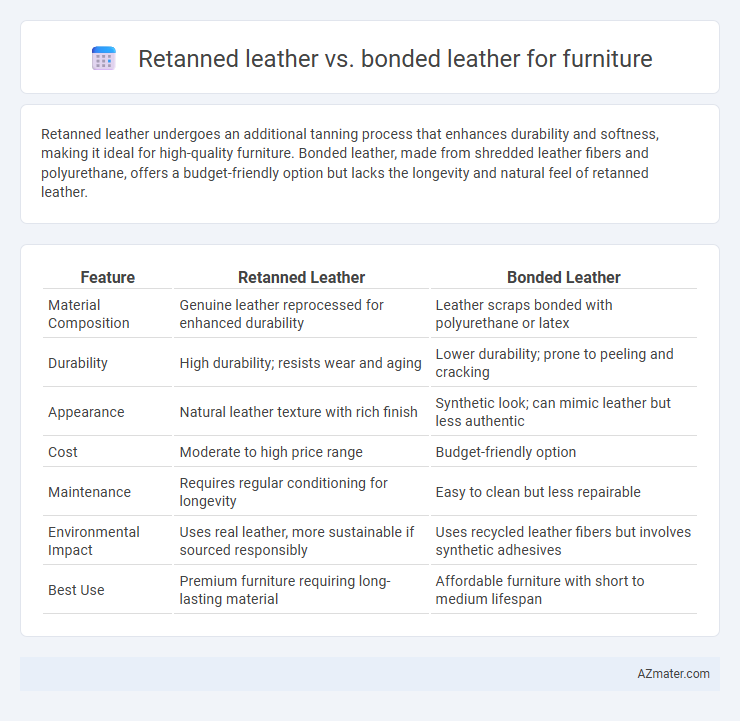Retanned leather undergoes an additional tanning process that enhances durability and softness, making it ideal for high-quality furniture. Bonded leather, made from shredded leather fibers and polyurethane, offers a budget-friendly option but lacks the longevity and natural feel of retanned leather.
Table of Comparison
| Feature | Retanned Leather | Bonded Leather |
|---|---|---|
| Material Composition | Genuine leather reprocessed for enhanced durability | Leather scraps bonded with polyurethane or latex |
| Durability | High durability; resists wear and aging | Lower durability; prone to peeling and cracking |
| Appearance | Natural leather texture with rich finish | Synthetic look; can mimic leather but less authentic |
| Cost | Moderate to high price range | Budget-friendly option |
| Maintenance | Requires regular conditioning for longevity | Easy to clean but less repairable |
| Environmental Impact | Uses real leather, more sustainable if sourced responsibly | Uses recycled leather fibers but involves synthetic adhesives |
| Best Use | Premium furniture requiring long-lasting material | Affordable furniture with short to medium lifespan |
Introduction to Retanned and Bonded Leather
Retanned leather is genuine leather that undergoes a secondary tanning process to enhance durability, softness, and color richness, making it ideal for high-quality furniture. Bonded leather is made by combining shredded leather fibers with a polyurethane or latex base, offering an affordable alternative with a leather-like appearance but less durability. Retanned leather provides superior longevity and texture, while bonded leather is favored for budget-conscious furniture buyers seeking a leather aesthetic.
Understanding Retanned Leather: Features and Benefits
Retanned leather undergoes a secondary tanning process that enhances its durability, softness, and resistance to wear, making it ideal for high-quality furniture. This leather type offers improved flexibility and a richer texture compared to bonded leather, which is manufactured from leather scraps bonded with polyurethane or latex. The superior strength and longevity of retanned leather ensure that furniture maintains its aesthetic appeal and comfort over time, providing excellent value for upholstery applications.
What is Bonded Leather? Composition and Characteristics
Bonded leather is a material made by combining shredded genuine leather fibers with a polyurethane or latex binder, pressed onto a fiber or fabric backing to mimic the appearance of full-grain leather. Its composition typically contains between 10% to 20% real leather mixed with synthetic substances, resulting in a uniform texture that is less durable and more prone to peeling or cracking compared to retanned leather. Bonded leather is favored for budget-friendly furniture options due to its affordability, but it lacks the natural breathability and long-lasting qualities of retanned leather, which undergoes additional tanning processes to enhance softness and durability.
Durability Comparison: Retanned vs Bonded Leather
Retanned leather offers superior durability compared to bonded leather, as it is crafted from whole hides that have undergone a tanning process to enhance strength and longevity. Bonded leather is made from leather scraps blended with binders, making it more susceptible to peeling and cracking over time, especially with frequent use in furniture. Furniture upholstered with retanned leather tends to maintain its appearance and structural integrity longer, providing better value and comfort in high-traffic environments.
Aesthetic Differences: Appearance and Texture
Retanned leather features a natural grain and rich texture resulting from a detailed tanning process, offering a luxurious and authentic appearance ideal for high-end furniture. Bonded leather, made from leather scraps blended with polyurethane, often exhibits a uniform, synthetic look with a smooth but less breathable surface, giving furniture a consistent but less natural aesthetic. The tactile experience of retanned leather is supple and varied, while bonded leather tends to feel stiffer and less resilient over time.
Comfort and Feel: User Experience
Retanned leather offers a supple, natural feel with enhanced breathability, resulting in superior comfort for furniture upholstery. Bonded leather, made from leather scraps bonded with polyurethane, tends to be stiffer and less breathable, often leading to a less comfortable sitting experience over time. Users typically prefer retanned leather for its durability and softness, which improves overall comfort and tactile satisfaction.
Environmental Impact and Sustainability
Retanned leather involves a natural process that reuses hides and reduces waste, promoting sustainability through fewer chemical treatments and lower environmental toxicity. Bonded leather, made from leather scraps bonded with synthetic materials and adhesives, contributes to higher environmental pollution due to the use of non-biodegradable components and increased chemical usage. Choosing retanned leather for furniture enhances eco-friendliness by supporting circular material use and minimizing landfill impact compared to bonded leather.
Maintenance and Care Requirements
Retanned leather requires regular conditioning with specialized leather oils to prevent drying and cracking, maintaining its durability and natural texture over time. Bonded leather, composed of leather scraps bonded with polyurethane, demands gentle cleaning with mild soap and water to avoid peeling and deterioration, as it is less resistant to wear. Proper care of retanned leather extends furniture lifespan significantly, while bonded leather offers a budget-friendly option but often needs more frequent maintenance and earlier replacement.
Cost Analysis: Price Differences
Retanned leather for furniture typically costs significantly more than bonded leather due to its higher-quality processing and durability. Bonded leather, composed of leather scraps and synthetic materials, offers a budget-friendly alternative but lacks the longevity and premium feel of retanned leather. The price difference can range from 30% to 70%, making bonded leather suitable for low-cost furniture while retanned leather remains the preferred choice for long-term investment pieces.
Which Leather Is Best for Furniture? Final Verdict
Retanned leather offers superior durability, natural texture, and breathability, making it the preferred choice for high-quality furniture that ages gracefully over time. Bonded leather, composed of leather scraps and synthetic materials, tends to wear quickly and lacks the resilience and luxurious feel of genuine leather. For long-lasting furniture with premium aesthetics and comfort, retanned leather stands out as the best option.

Infographic: Retanned leather vs Bonded leather for Furniture
 azmater.com
azmater.com